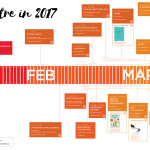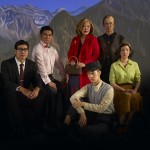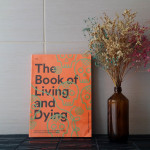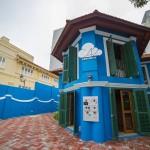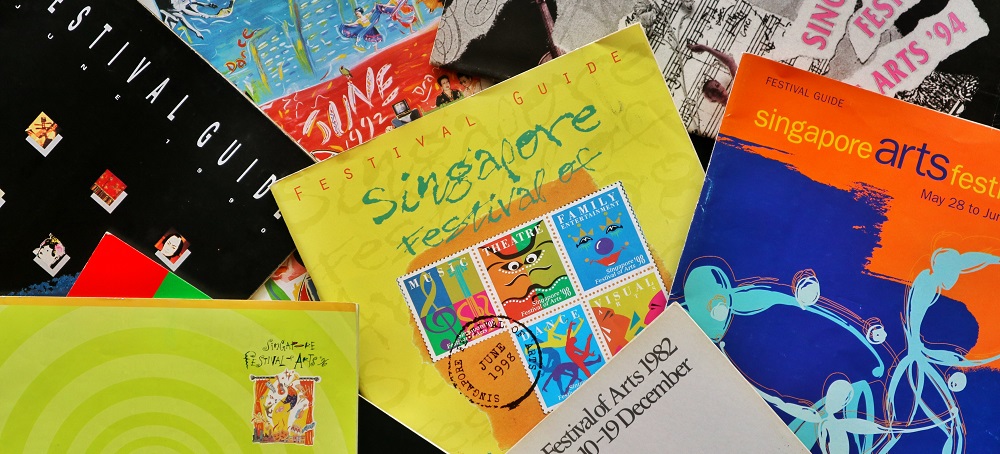
See a collection of past national arts festival programmes at the Singapore International Festival of Arts’ Four Decades exhibition from 26 April 2018. Photo: Gwen Pew. Programmes used with permission from Arts House Limited.
The Singapore International Festival of Arts 2018 celebrates its four-decade heritage as the premier arts and cultural event in independent Singapore. In this essay, we look back even further in our history to see how our national arts festival came about.
Within the social sciences, festivals are viewed as sites for the production (and consumption) of culture. Waterman (1998) takes this notion a step further by asserting that:
… festivals provide a means whereby groups may attempt to maintain themselves culturally, while presenting opportunities to others to join that group. Festival is also an occasion for outsiders (sponsors, subsidizers) to endeavour to force or lead the group towards an acceptable course for the continuity of its culture. (p.55)
It is through this culture-making frame that we look back at Singapore’s history with the national arts festival. It is arguable that because of its culture-making function, some arts festivals are referred to as ‘cultural festivals’ in historical records. This is why in this essay some events identified as cultural festivals will also be included.
The main consideration for inclusion of these cultural festivals would be if they had been intended to bring together many different cultures, much as arts festivals are events aggregating more than one art form (hence ‘arts’ as opposed to ‘art’). This speaks to the nature of art as both a byproduct of a culture as well as involved in cultural production as well. There was also consideration for the scale of the festival event, which should be cited as somewhat large, although regrettably there is no quantitative indicator for this criteria.
Seeding the idea of a Singapore arts festival
The idea that Singapore needed a city-wide arts event first emerged on public record in 1949, while the island was still part of the British Colony. On July 17, 1949, a Straits Times (ST) article reported that several unidentified cultural organisations were in support of an annual festival of arts, specifically as a money-making venture to raise funds for local arts groups.
The proposed plan was for a festival based on traditional regional music, arts and crafts, drama, and dance; revenue would come mainly from the engagement of a prestigious foreign act such as an Australian symphony orchestra. A supporter of the plan was quoted as saying: “I’m sure we could make profit enough to subsidise our own symphony orchestra, and to make grants to the University of Malaya and cultural organisations in Singapore” (para. 4).
The call for an arts festival emerged again in the news in 1951, from Mr. T. P. F. McNeice, the president of the Singapore City Council, a colonial administrative body in charge of the city’s utilities and infrastructure. At the opening of an arts exhibition, McNeice declared that a Singapore Festival of Arts would be a showcase of the city’s multiracial harmony, putting Singapore in the position to be “a cultural centre not only for South East Asia but for the whole world” (ST, 1951, para. 4).
The idea began gathering traction in the latter half of the ’50s following the formation of the Singapore Arts Council in 1955. In his book Making the invisible visible: Three decades of the Singapore Arts Festival, Purushothaman (2007) writes that the first Singapore Arts Council meeting to mention plans for a festival was held in 1956. Subsequent ST articles in 1957 and 1958 make mention of a pesta or festival in Malay to be organised by a committee appointed by the Singapore Arts Council. The festival was mooted by Permanent Secretary to the Ministry of Education Mr Lee Siow, who said that it “would be mainly a Singapore affair, its international character coming from the different races in the Colony” (ST, 1957, para. 3).
Singapore Arts Festival 1959: Culture-making for colonial Singapore
The first Singapore Arts Festival took place in April 1959. It was an ambitious undertaking, spanning eight consecutive days in April and across multiple venues, including Victoria Theatre and Memorial Hall, the Cultural Centre, Beatty School, and the Padang, the open lawn in front of City Hall. A ST (1959a) article reporting on Festival listed participating groups such as the Chinese theatre troupes, the Singapore Musical Society and Chamber Ensemble, the Indian Fine Arts Society, amateur theatre group Stage Club, and school clubs. According to Dr. Michael Sullivan, chairman of the Singapore Arts Council: “The festival will mark the biggest concentration of the Arts Singapore has ever know. It will be a people’s festival in the broadest sense of the word” (Morgan, 1959). The festival was supported by a $20,000 grant from the colonial government (ST, 1958).
In the programme guide for the 1959 Festival, Sullivan writes that, through the festival, the Singapore Arts Council aims “to bring the arts of Singapore to the people of Singapore; to stimulate new ventures in the arts; and to lay the foundation for making Singapore an international cultural centre for South East Asia” (as cited in Purushothaman, 2007, p. 31).
In the aftermath, local news outlets praised the inaugural festival for drawing large crowds, with the Singapore Free Press (SFP) reporting that an estimated 12,000 people watched the shows in the indoor venues (Wee, 1959). ST (1959c) claimed over 500 people watched an outdoor concert in the Padang despite poor weather.
With the success of the first festival, a spokesperson for the Singapore Arts Council later said that there was a high possibility the festival would become an annual occurrence (Wee, 1959). On the 1959 Festival’s culture-making function, Purushothaman (2007) observed that its organisation was “to find a common ground for a nation comprised of a diasporic generation seeking to locate and produce a culture of their own” (p. 32).
However, with the end of colonialism in sight and Singapore achieving full self-governance in 1959, the purpose of an arts festival was to grow far more nationalistic. As one ST reporter writes: “The [first] Festival comes just as Singapore is moving into an era of self-awareness… It is a fitting prelude to the larger drama that is about to begin (ST, 1959c).
Cultural Festival: Consolidating a Malayan culture and identity
The new decade saw fervent interest in constructing a new postcolonial Malayan culture and identity for the colonies seeking their independence. With Singapore’s newly-elected government formed by the People’s Action Party in 1959 came the Ministry of Culture, set up in the same year to “engineer social and cultural integration” (Purushothaman, 2007, p.32). In service of that function, news records speak of an annual Cultural Festival or Pesta Kebudayaan, organised by the Ministry of Culture annually from 1960 to 1962. These yearly large-scale events appear separate from the frequent but much smaller Aneka Ragam Ra’aya or People’s Cultural Concerts, also organised by the Ministry of Culture during the period.
The first Cultural Festival was a week-long affair held at the Victoria Theatre in September 1960. According to ST (1960a), “the [festival] presentations would have a “Malayan bias,” and would depict the harmonious blending of the various communities in Malaya” (para. 4). The festival programme included plays “set in the local background with Malayan themes” (para. 7), dance items which featured “classical and folk dances of the four cultural streams” (para. 11), as well as a concert by the Singapore Chamber ensemble. Chia (1960) reports that the festival involved some 300 local artists from 15 cultural organisations.
The purpose of the Cultural Festival was laid out clearly by Inche Yusok Ishak, then Head of State:
…with the political changes in the Federation and Singapore, the concept of a Malayan culture had become an essential part of building a Malayan nation.
He stressed that, seen in this light, all the work of the Ministry of Culture, as well as various arts and cultural organisations to bring the arts to the masses was “clear proof” of their seriousness and determination to lay the foundations for a Malayan culture.
(ST, 1960b, para. 7)
Acting Prime Minister Dr. Toh Chin Chye, who opened the second Cultural Festival in 1961, echoed these sentiments: “The arts form an important instrument for the task of nation-building […] This Cultural Festival brings together the arts of our different communities and in doing so, it also brings the communities together” (ST, 1961, para. 8-9). Over 3,000 adults and 800 school children were reported to have taken part in the second edition (SFP, 1961; ST, 1961a).
In 1963, construction for the new National Theatre had been completed. To celebrate the opening of the theatre, a greatly expanded South-East Asian Cultural Festival was planned, involving 1,500 artists from 11 countries in the Asia region in a one-week performing arts programme in August (ST, 1963b). Billed “the greatest show in the East”, the main festival programme was staged at the National Theatre and Victoria Theatre, as well as free outdoor shows outside City Hall, at Hong Lim Green and at the Bukit Timah Community Centre (ST, 1963d).
The South-East Asian Cultural Festival was primarily organised as an opportunity to strengthen cultural relations between Singapore and its neighbours in the region, especially with the withdrawal of the British. Mr. K. C. Lee, Parliamentary Secretary to the Ministry of Education, had “made clear to [the cultural leaders of the invited countries] that this festival was a nonpolitical gathering, mainly designed to deepen understanding and forge stronger cultural links among peoples of Asian countries” (ST, 1963a, para. 5). In a message published in ST (1963c), Minister for Culture Mr. S. Rajaratnam reiterated the making of a united South-East Asian culture through the 1963 Festival:
This festival would not have been possible when the countries of South-East Asia languished under colonial domination…
All the countries which are participating in this Festival have three common golden thread [sic] running through the rich tapestries of their cultural life.
These common influences are the Malaysian, Chinese and Indian heritages.
(para. 5; 8-9)
But the years to follow the 1963 Festival were tumultuous, with Singapore’s merger with the Federation of Malaysia, in September of the same year, and its subsequent expulsion in 1965. This may be why no other large-scale arts or cultural festivals were planned for over a decade until 1977.
Singapore Festival of Arts 1977: A people’s festival
The Singapore Festival of Arts held in 1977 is widely accepted as the first national arts festival of independent Singapore. It was organised by the Ministry of Education through its youth arm, the Young Musicians Society (YMS).
Oddly, the Ministry of Culture was not involved with the planning of the inaugural arts festival. Purushothaman (2007) mentions the highly politicised, anti-establishment nature of the local art scene as well as the Ministry of Culture embarking on its own bevy of community-level arts and cultural programmes aimed at uniting the nation during the ’70s; these could be reasons for the glaring absence of Ministry of Culture in the 1977 Festival.
Another reason for the lack of public (and private) support for a national arts festival could be the anticipated poor returns on huge investments. The frequent point of comparison in news records of the decade was the annual Hong Kong Arts Festival, which began in 1973 and was conceived by the Hong Kong Tourist Association and British Airways to reach out to international audiences. It was the biggest arts festival in Asia and the third largest in the world, and soon became the premier cultural event in the region, drawing huge crowds in its month-long programme (Lee, 1976; ST, 1973, 1977).
A ST article cited lukewarm interest in the public and private sectors in supporting a Singapore arts festival (Lee, 1976). An unnamed local musician was quoted as saying:
It is not that the Hongkong [sic] people are better than Singaporeans in organising such a spectacular international festival. It is simply that they are never short of generous sponsorship from commercial houses and airlines and front line encouragement from the government.
(para. 4)
The same article mentions poor local audience numbers for arts events; additionally, a spokesperson for the Singapore Tourist Promotion Board (a precursor of today’s Singapore Tourism Board) said an arts festival in Singapore would not be commercially viable because it would not draw in tourists.
Nonetheless, a public call appeared in ST in 1976 for amateur artists – students and adults, individuals and groups – to participate in the first Singapore Festival of the Arts, slated to be held in April the following year. The main sponsor of the festival was multinational oil company Mobil, who pledged a total of $80,000 for the event. Public relations manager for Mobil, Mr. John Lim, is reported to have originated the idea for the festival, expanding the YMS’s initial proposal of a one-day concert into a six-day affair held at Victoria Theatre. Mr. Lim said:
Unlike the Hongkong [sic] Arts Festival, that is, which brings in top performers from all over the world, it becomes really a showcase of world talent assembled in Hongkong [sic]. A good thing in its own way, Yes, but it does nothing to encourage a lot of local participation – which is precisely what we are wanting to do.
(CKT, 1977, para. 24)
The 1977 Festival’s purpose was to build a cohesive Singaporean culture. Mr. Alex Abishegenaden, vice-chairman of the Young Musicians Society, said: “This [Festival] will be essentially Singaporean. So a Singaporean identity and culture will be evolved” (ST, 1976, para. 5). To that end, the open call was met with huge public interest – more than 1,300 participants were selected to perform in the programme; the participants also received cash prizes totalling $14,000 (CKT, 1977).
The high uptake of the festival was enough to spur the planning of the next festival in 1978, with Mobil almost-doubling its sponsorship to $150,000 (ST, 1978). The Ministry of Culture joined in the organisation of the 1978 Festival. Public and private support also grew over the ensuing years with new sponsors such as the Singapore Tourist Promotion Board and Singapore Airlines coming on board in later editions of the festival. Ever since 1977, there has been a national arts festival held every one or two years.
By Daniel Teo
Published on 3 April 2018
To find out how the story continues, visit Four Decades, an exhibition of ephemera from Singapore’s past national arts festivals, presented by Singapore International Festival of Arts 2018. The exhibition, which is supported by Centre 42’s Repository, includes a collection of past national arts festival programmes on display. Four Decades takes place on the 2nd Floor Corridor of The Arts House from 26 April to 12 May 2018. Admission is free.
References
Chia, H. (1960, September 6). 300 local artists for States pesta. In Singapore Free Press. Downloaded from NewspaperSG archive.
CKT. (1977, April 25). A cultural reservoir?. In Business Times. Downloaded from NewspaperSG archive.
Lee, P. (1976, September 15). Not enough support for festival of the Arts. In Straits Times. Downloaded from NewspaperSG archive.
Morgan, L. (1959, March 30). Panorama of the cultures of the East. In Straits Times. Downloaded from NewspaperSG archive.
Purushothaman, V. (2007). Making the invisible visible: Three decades of the Singapore Arts Festival. Singapore: National Arts Council.
Singapore Free Press. (1961, August 18). All set for States big cultural festival. Downloaded from NewspaperSG archive.
Straits Times. (1949, July 17). Plan for annual arts Festival. Downloaded from NewspaperSG archive.
Straits Times. (1951, December 13). Spore urged: ‘Form Festival of Arts’. Downloaded from NewspaperSG archive.
Straits Times. (1957, November 27). Now a Singapore pesta. Downloaded from NewspaperSG archive.
Straits Times. (1958, November 25). Arts Council plans pesta for S’pore. Downloaded from NewspaperSG archive.
Straits Times. (1959a, March 7). Eight-day festival of drama, dance. Downloaded from NewspaperSG archive.
Straits Times. (1959b, March 30). Arts festival. Downloaded from NewspaperSG archive.
Straits Times. (1959c, April 6). Big crowds at festival concerts. Downloaded from NewspaperSG archive.
Straits Times. (1960a, August 22). Week-long cultural festival. Downloaded from NewspaperSG archive.
Straits Times. (1960b, September 13). Culture festival is opened. Downloaded from NewspaperSG archive.
Straits Times. (1961a, May 12). Singapore plans a super art show. Downloaded from NewspaperSG archive.
Straits Times. (1961b, August 20). Role of the Cultural Festival in nation building. Downloaded from NewspaperSG archive.
Straits Times. (1963a, July 11). Singapore the big, big show. Downloaded from NewspaperSG archive.
Straits Times. (1963b, August 7). 1,500 from 11 countries to perform from tomorrow. Downloaded from NewspaperSG archive.
Straits Times. (1963c, August 8). A historic event, milestone of an era says Rajaratnam. Downloaded from NewspaperSG archive.
Straits Times. (1963d, August 8). Greatest show in the East open in Singapore today. Downloaded from NewspaperSG archive.
Straits Times. (1973, February 28). HK Arts Festival opens to near capacity houses. Downloaded from NewspaperSG archive.
Straits Times. (1976, October 13). Arts Festival in April to evolve local art-form. Downloaded from NewspaperSG archive.
Straits Times. (1977, March 31). Lesson Spore can learn from the HK arts festival. Downloaded from NewspaperSG archive.
Straits Times. (1978, June 10). Arts Festival to be made event of world standing. Downloaded from NewspaperSG archive.
Waterman, S. (1998). Carnival for elites? The cultural politics of arts festivals. In Progress in Human Geography, 22(1), 54-74.
Wee, E. (1959, April 9). Arts Festival to be permanent annual fixture. In Singapore Free Press. Downloaded from NewspaperSG archive.
Update (10 April 2018): “Pesta Kenudayaan” in paragraph 14 was spelt incorrectly. It has been amended as “Pesta Kebudayaan”.
Update (30 April 2018): Introduction paragraph rewritten to better contextualise the article within SIFA 2018’s celebration of its four-decade heritage.

